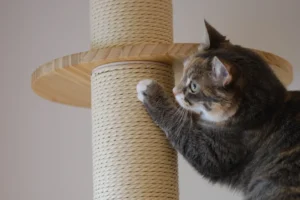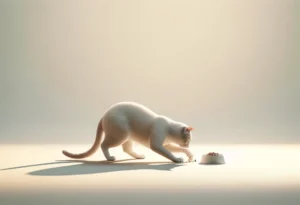Note: We may earn a commission from helpful, relevant links in our content. No cost to you. See our privacy policy.
Cats: adorable, fluffy sovereigns of our hearts and homes, notorious for their love affair with scratching everything in sight. Just when you sweetly gaze into those big, innocent eyes, your furry friend turns your favorite sofa into a shred-fest.
In this post, we’ll unveil time-tested and innovative solutions to save your furniture while keeping your feline overlord purring in delight.

Quick Takeaways:
- Redirect cat scratching with a mix of sisal posts, catnip, and strategic placement near sleeping areas or targeted furniture.
- Protect furniture by applying double-sided tape, using citrus sprays, or covering with microfiber or Crypton fabric for scratch resistance.
- Consider nail caps for a safe way to reduce furniture damage without inhibiting your cat’s natural scratching behavior.
Why Do Cats Scratch, Anyway?
Cats scratch for a whole host of reasons, and understanding these can be a real eye-opener. First off, territory marking.
Those sharp little claws do more than just annoy you; they leave both a visual marker and a scent that says “I live here” to any other feline passerby. Then there’s nail maintenance. Just like us, cats need to take care of their nails, except instead of a mani-pedi, they opt for the couch to shed the outer nail layers and keep them sharp. Lastly, scratching is a major stress reliever for cats. It’s their way of stretching and relieving tension – think of it as their form of yoga.
Can You Train a Cat Not to Scratch Furniture?
Believe it or not, you can teach an old (or young) cat new tricks. Training your furry friend to ditch the couch and embrace a scratching post involves patience, but it’s definitely doable. Here’s the scoop:
- Praise and treats: Just caught your cat using the scratching post? Time for a treat and some loving words. Positive reinforcement goes a long way.
- Redirect, don’t scold: If you find your cat’s claws on the wrong item, gently move them to the scratching post. No yelling – it just scares them and solves nothing.
- Make the unwanted surfaces less appealing: Double-sided tape or aluminum foil can deter your cat from furniture, making the scratching post the more appealing option.
Consider pheromone diffusers or sprays for that high-strung kitty. These products can calm your cat, making them less likely to take stress out on your furniture.
What Scratch-proof Furniture Options Are There?
Not all furniture is created equal when it comes to surviving the feline claw. But fear not, there are indeed materials that stand a better chance against your kitty’s sharp affections.
-
Microfiber : Soft, durable, and more resistant to scratching, microfiber (especially the tight-weave kind) is a godsend for pet owners. An example is the Lifestyle Solutions Harvard Microfiber Sofa – chic yet resilient.
-
Leather : A tougher option that can withstand some scratching. However, go for quality, as cheaper leather might not hold up as well. Also, remember that scratches can add “character” to leather over time.
-
Crypton : A nearly indestructible fabric that’s resistant to stains, smells, and, crucially for us, scratching. It’s an excellent choice for those who want upholstered furniture without the worry. The Crypton Store offers a variety of furniture options that feature this durable fabric.
Here’s a nifty tip that’s often overlooked: cat-friendly furniture designs. Certain furniture pieces, like cat trees or shelves, integrate scratching posts and lounging spots. Brands like Tuft + Paw specialize in modern, stylish furniture that’s designed with your cat’s needs in mind, offering an aesthetic appeal that doesn’t scream “pet furniture” and might just be the unique solution you’re looking for.
Remember, dealing with a cat’s natural behaviors doesn’t mean you have to settle for a less stylish home. Understanding why they do what they do, being patient in redirecting their habits, and choosing the right materials can ensure your furniture, and your cat, can live in harmony.
How Effective Are Scratching Posts and Pads?
When it comes to safeguarding your furniture from your feline friends, scratching posts and pads are often the first line of defense. Their effectiveness, however, hinges on various factors, including the type, placement, and what specifically entices your cat to them. Let’s paw through your options and how to make them work for you.
Types at a Glance
Scratching posts and pads come in all shapes, sizes, and materials, which can make all the difference in their appeal to your cat. The most popular materials include:
- Carpet: Mimics the texture of many home furnishings but can fray easily.
- Sisal: A robust material that many cats love for its texture, ideal for heavy scratchers.
- Cardboard: Affordable and often infused with catnip, though not the most durable.
- Wood: Offers a natural and sturdy option for cats who prefer a more rugged surface.
Making Them Irresistible
Wondering how to divert your cat’s attention from the corner of your new sofa to a scratching post? Here are some tips:
- Location, Location, Location: Cats often scratch after waking up, so placing a post near their sleeping area can be a game-changer. Additionally, positioning it next to the furniture they tend to target can help redirect their scratching instincts.
- Catnip & Treats: A sprinkle of catnip or some hanging treats can make the scratching post the most interesting spot in the room.
- Multiple Options: Cats are individuals with distinct preferences. Having various types of scratching surfaces around your home can cater to their moods and keep all your furniture safe.
Remember, patience and positive reinforcement are key. Encourage your cat with praise and treats when they use the post or pad. And by unique tip? Try a bit of lavender oil near the base of the post. Many cats find it calming, and it might just draw them in. Just ensure it’s a safe, pet-friendly product.
Are Nail Caps a Safe Solution?
Nail caps are like tiny, soft thimbles for your cat’s claws. Made of vinyl or silicone, they’re designed to blunt the claws, making them less destructive while allowing the typical extension and retraction. But are they a kitty fashion statement or a faux pas?
The Lowdown on Nail Caps
- Application: They’re glued to the cat’s nails and typically last 4-6 weeks, corresponding with the natural nail growth cycle.
- Safety: When applied correctly, nail caps are considered safe—they don’t interfere with claw retraction or the cat’s ability to walk. However, it’s crucial to ensure the correct size and to check regularly for signs of discomfort or infection.
- Behavioral Impact: While they don’t inhibit the scratching behavior itself (your cat will likely continue to “scratch”), they significantly reduce the damage done to furniture, carpets, and potentially humans.
Despite their benefits, nail caps aren’t without controversy. Critics argue they can hinder certain natural behaviors or lead to potential nail issues if not monitored closely. Thus, it’s crucial to talk to your vet and weigh the pros and cons before making a decision.
What Deterrents Can Safely Discourage Scratching?
If you’re seeking ways to keep your cat’s paws off certain areas without resorting to negative reinforcement, there are several safe and effective strategies to consider:
- Citrus Sprays: Cats generally dislike the smell of citrus. A homemade or store-bought citrus spray can keep them at bay from certain furniture or areas without causing harm.
- Double-Sided Tape: Cats detest the sticky sensation on their paws. Placing double-sided tape on surfaces you want to protect can work wonders as a temporary deterrent.
- Furniture Protectors: Clear plastic protectors can shield your furniture’s corners without detracting from your home’s aesthetics. They’re particularly useful during the training phase with scratching posts.
- Strategic Placement of Scratching Posts: Already touched on but worth reiterating, sometimes the best deterrent is a better alternative. Positioning scratching posts and pads strategically can naturally deter your cat from unwanted areas.
Did You Know? Cats detest the feel of aluminum foil under their paws. For a unique deterrent, temporarily covering your furniture with foil can discourage scratching.
By combining these strategies with the positive reinforcement of using scratching posts and pads, you can guide your cat towards more appropriate scratching behaviors. Remember, the goal isn’t to punish but to redirect and encourage healthier habits that work for both of you.
Alex, a passionate animal lover, has experience in training and understanding animal behavior. As a proud pet parent to two dogs and three cats, he founded AnimalReport.net to share insights from animal experts and expand his knowledge of the animal kingdom.









